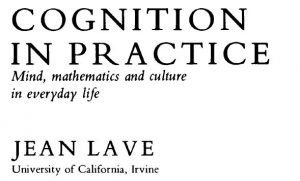Théories et pratiques de l’apprentissage situé 39/101

Cognition in practice (21/n)

Introduction
Dans cette nouvelle section du chapitre 7 du livre de Jean Lave, Cognition in Practice, il s’agit toujours d’argent. Une fois encore, je vais faire court, et présenter un extrait de la partie introductive et de la conclusion. En substance, en matière de gestion de l’argent l’on fait face à des dilemmes, des contradictions et conflits qu’il faut résoudre, ce qui n’est pas toujours fait sur des bases strictement rationnelles…
Dilemmes et résolution
Dilemmes et résolutions
Le nombre élevé d’enveloppes semble naitre des valeurs contradictoires sur la manière dont doit être géré l’argent
The formation of incommensurate stashes appears to grow out of contradictory values about how money should be managed. There is a belief in Western culture that within the family, money is to be used to express and create solidarity and collective well-being. This conflicts with values supporting the utilitarian character of exchange, and adversary relations between buyer and seller in the world at large. In turn, this presents families with dilemmas about how to negotiate the entry, internal circulation, and expenditure of money.
Les problèmes commencent avec la paie, comment la transformer en une propriété collective
The problems begin with paychecks. A paycheck inextricably belongs to a family member. Yet once money is associated with the family, it must be transformed into collective property. In twenty-five interviews only one family reported routine direct transfers of cash from one spouse to the other.
Les stratégies pour ce faire ne manquent pas
There were several common strategies for transforming money from individual income into collective resource. AMP participants deposited money into a checking account on which both spouses wrote checks. Often the spouse drawing most heavily on the account was not the one who made the major deposits. When both spouses worked, both paychecks were often deposited into a single family account, erasing the association of specific sums with particular individuals.
(stratégies) Qui consistent parfois à gommer la connotation individualiste associé à une paie et l’affectant à une certaine dépense spécifique (comme les vacances)
The individualistic connotations of paychecks were sometimes « laundered » away by allocating one to a specific category of expenses for the family, so that in effect it was redefmed in terms of its uses rather than its source Thus, income from part-time employment was sometimes described as« earning the family vacation. » …
…
Dans les formes culturelles occidentales de gestion de l’argent, le conflit entre les valeurs individuelles et collectives s’exprime par l’inhibition de la propriété individuelle afin de réaliser les valeurs collectives.
In Western cultural forms of money management, conflict between individual and collective values is expressed as the suppression of individual ownership in order to achieve collective values. But relations between individual and collective resources are not « natural » properties of the monetary system or of some universal division between domestic and public domains.
Le contraste avec les cultures africaines doit ausi être signalé
It is perhaps easier to see this by contrast with African cultures described fairly shortly after Western money became common. In some cases the individualized character of forms of wealth had been a positive factor in reaching collective goals (Parkin 1980). Customary stashes took the form of individually known and named cattle. Individualization of these non-concealable resources was crucial in realizing collective commitments to furnish brideprice among a wide network of kinsmen.
L’introduction des monnaies étrangères ayant un impact négatif sur les traditions…
The introduction of Western currency had an adverse effect on this project, since it was not possible to track particular dollars over the years between a promise to contribute and an actual contribution, as it had been with a familiar herd of cattle. It may have been just the uniform characteristics of Western currency that destroyed accountability in that case, while providing an expressive medium for the transformation of income into collective resource in the present case.
Un autre dilemme dans la recherche de l’équilibre entre fonds individuels et collectifs portait sur les montants, et dans quels médias, les conjoints (et les enfants) disposaient de sommes d’argent dont ils n’étaient pas tenus de rendre compte à la famille
Another dilemma associated with balancing individual and collective funds in the family had to do with the amounts, and in what media, spouses (and children) had monies for which they were not accountable to the family. Accountability started with the question of how much income was generated by the individual, and went on to questions about the kinds of stashes in which it was assembled and on what it was spent. For instance, C discussed what she and some other participants described as « mad money. »
Interviewer: Do you have a sense of how much cash you have on hand?
C: Every bit .. I keep about one hundred dollars in mad money in the back of my wallet andE’ll say, « Honey could I have twenty dollars of your mad money? »See, I keep about one hundred dollars that don’t counL That’s mad money. But they all pay me back.
Interviewer: What kind of things do you buy out of mad money?
C: Things you want to buy. I love to do ceramics. They’re foolish because you know I have no place to put all the things that …
Et les contractions provoquent des conflits qu’il faut résoudre
Contradictions as fundamental as collective/individual funds, and communal/individual accountability for their expenditure precluded a single, simple solution to the problem of allocating funds between their arrival and expenditure. Instead, there were conflicts to be resolved, entailing a series of arrangements that allowed the same funds to be treated sometimes as collective (though brought into the family individually), and occasionally as individual (even though taken from a common fund).
En résumé
Qu’est qui est spécifique à la gestion de l’argent « en situation »? Cela commence par des activités qui cherchent à résoudre les contradictions et, cela reflète les relations de famille de manière différente selon les familles.
“Let us sum up what is situationally specific about the management of money. To begin with, in contradiction-resolving activity, stashes, media of payment and their combinations are used to transform legal tender into incommensurate categories and paths for funds coming and going through the family. They reflect family relations differently for different families. And the particular unitization of money in a given family shapes spheres of exchange so that they are commensurate with activities, social relations, values and occasions on which issues are resolved.”
Mais, plus encore, cette discussion sur la gestion de l’argent a recadré la question de la résolution de problèmes en terme de dilemmes motivés par des contradictions et leurs résolutions partielles et changeantes.
But further, this discussion of money management, like the Weight Watchers study, has framed the issue of problem solving in terms of contradiction-motivated dilemmas and their partial and shifting resolutions, and this too helps to account for the assembly of quantitative relations in situationally specific ways. What motivates problem-solving activity in everyday situations appears to be dilemmas that require resolution. It is necessary, in managing contradictory principles, to arrive at a resolution in specific terms and not necessarily in stable ones for a dilemma has no factual solution, no general, in principle, correct answer. It is a matter of conflicting values and viable alternatives, which are neither right nor wrong, and none of which is entirely satisfactory
Pour finalement noter un changement dans la conception de l’activité de résolution de problèmes:
d’une activité indépendante des valeurs et du contexte à une activité chargée de valeurs, guidée par les conflits et spécifique à la situation.
There is a shift here in the conception of problem solving activity from a value free, context free technology of means, to a value laden. conflict driven, situationally specific
Billets précédents
Billet 1: Définitions de l’apprentissage situé
Billet 2: Pourquoi s’intéresser à la théorie de l’apprentissage situé?
Billet 3: Démarche et retour aux sources
Billet 4: Mai 1968 et l’apprentissage situé
Billet 5: Apprentissage situé et conversation
Billet 6: Lucy Suchman, mon téléphone portable et moi
Billet 7: Conversations avec moi-même (n° 1)
Billet 8: L’apprentissage situé mis en pratique, cela ferait quoi?
Billet 9: Contribution de la psychologie soviétique à la théorie de l’apprentissage situé
Billet 10: Les apports de la philosophie à la théorie de l’apprentissage situé
Billet 11: Focus sur l’école Dewey
Billet 12: Apports de la psychologie de la perception – la notion d’affordance
Billet 13: Apprentissage situé et intelligence artificielle, deep learning, réalité virtuelle, réalité augmentée, etc…
Billet 14: Conversations avec moi-même (N°2)
Billet 15: Quand John Dewey rencontre Jean Lave
Billet 16: Cognition in Practice (1/n)
Billet 17: Cognition in Practice (2/n)
Billet 18: Cognition in Practice (3/n)
Billet 19: Cognition in Practice (4/n)
Billet 20 : Cognition in Practice (5/n)
Billet 21: « Conversations avec moi même N°3 »
Billet 22: Cognition in Practice (6/n)
Billet 23: Cognition in Practice (7/n)
Billet 24: Cognition in Practice (8/n)
Billet 25: Cognition in Practice (9/n)
Billet 26: Cognition in Practice (10/n)
Billet 27: Cognition in Practice (11/n)
Billet 28: « Conversations avec moi-même N°4 »
Billet 29: Cognition in Practice (12/n)
Billet 30: Cognition in Practice (13/n)
Billet 31: Cognition in Practice (14/n)
Billet 32: Cognition in Practice (15/n)
Billet 33: Cognition in Practice (16/n)
Billet 34: Cognition in Practice (17/n)
Billet 35: « Conversations avec moi-même N°5 »
Billet 36: Cognition in Practice (18/n)
Related Posts
Quand Sarah (ré)invente le Codev
Communauté de pratique et management de la formation – 2/6
Codéveloppement à haute vitesse 3/n
Articles récents
Archives
- juin 2025
- mars 2025
- novembre 2024
- octobre 2024
- août 2024
- mai 2024
- mars 2024
- janvier 2024
- décembre 2023
- septembre 2023
- juin 2023
- avril 2023
- mars 2023
- janvier 2023
- octobre 2022
- septembre 2022
- juillet 2022
- mai 2022
- avril 2022
- mars 2022
- février 2022
- janvier 2022
- octobre 2021
- août 2021
- juillet 2021
- mai 2021
- février 2021
- juin 2020
- mai 2020
- avril 2020
- février 2020
- janvier 2020
- décembre 2019
- novembre 2019
- octobre 2019
- septembre 2019
- août 2019
- juillet 2019
- mai 2019
- avril 2019
- mars 2019
- février 2019
- janvier 2019
- décembre 2018
- septembre 2018
- août 2018
- juillet 2018
- juin 2018
- mai 2018
- avril 2018
- mars 2018
- février 2018
- janvier 2018
- décembre 2017
- novembre 2017
- octobre 2017
- septembre 2017
- août 2017
- juin 2017
- mai 2017
- avril 2017
- mars 2017
- février 2017
- janvier 2017
Catégories
- Actualités
- Adaptive Learning
- Allemagne
- Apprendre
- Apprentissage
- Branding
- Business
- Coaching
- Codeveloppement
- Communautés de pratique
- Deep learning
- Design
- Development
- E-Learning
- Ecole
- écologie
- Education
- Europe
- Formation
- Histoire
- IA
- Intelligence articificielle
- LBC
- metacognition
- Non classé
- Orientation
- orientation
- Philosophie
- Poésie
- Réalité Augmentée
- Réalité Virtuelle
- Transition digitale
- WOL





Commentaires récents